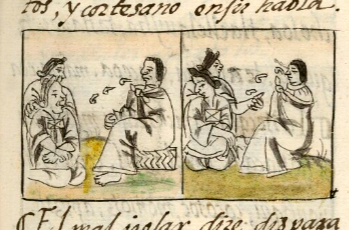tlaquetzqui (FCbk10f26r)
This iconographic example, featuring a storyteller (tlaquetzqui), is included in this digital collection for the purpose of making comparisons with related hieroglyphs. The term selected for this example comes from the text near the image in the Digital Florentine Codex. There is no gloss, per se. This example shows a fully clothed man seated on a low woven seat (icpalli). He wears a large cloak (tilmatli), probably over a Spanish-style shirt and trousers, but the latter are not visible.The cloak is tied in front over his chest. His clothing is shaded in places to give it a three-dimensionality, evidence of European artistic influences. Three volutes or speech scrolls emerge from his mouth in the direction of the two women who are listening. They are dressed traditionally with huipiles and nahuas (also three-dimensional), and their hairstyle is the neaxtlahualli or axtlacuilli, the traditional way for adult women to wear their hair, with two points above the forehead. One of the women seems especially engaged with the story. The text describes the storyteller with great praise, as though this practice was highly revered.
Stephanie Wood
Storytelling is not an obvious theme in this digital collection. But origin stories have a prominent life in the popular personal names of Xiuhnel and Mimich, two “cloud serpents” (apparently, stars) who figure in many migration stories. Also, there is a little person (tzapatl) featured in a story about an omen (see below).
Stephanie Wood
tlaguetzgui
tlaquetzqui
Stephanie Wood
1577
Jeff Haskett-Wood
volutas, cuentistas, cuentos, historias, relato, relatos, narrativas, narración, decir, escuchar
tlaquetzqui, a storyteller, https://nahuatl.wired-humanities.org/content/tlaquetzqui
el cuentista
Stephanie Wood
Available at Digital Florentine Codex/Códice Florentino Digital, edited by Kim N. Richter and Alicia Maria Houtrouw, "Book 10: The People", fol. 26r, Getty Research Institute, 2023. https://florentinecodex.getty.edu/en/book/10/folio/26r/images/0 Accessed 5 September 2025.
Images of the digitized Florentine Codex are made available under the following Creative Commons license: CC BY-NC-ND (Attribution-NonCommercial-NoDerivs 4.0 International). For print-publication quality photos, please contact the Biblioteca Medicea Laurenziana ([email protected]). The Library of Congress has also published this manuscript, using the images of the World Digital Library copy. “The Library of Congress is unaware of any copyright or other restrictions in the World Digital Library Collection. Absent any such restrictions, these materials are free to use and reuse.”





